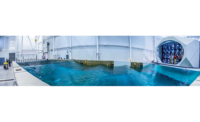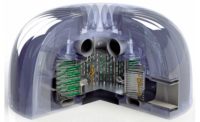When Turner Construction Co. introduced business information modeling (BIM) for building the new University Medical Center of Princeton, it immediately inspired a medical metaphor for the owner: brain imaging technology used by neurosurgeons.
Barry Rabner, president and CEO of Princeton Healthcare System, the owner of the Plainsboro, N.J.-based medical center, compared BIM to how neurosurgeons inject blood vessels with dye and rotate images of the brain on an axis. “As the owner we wanted to keep costs as low as possible while maximizing usable space,” he says. “BIM helped reconcile those needs.”
That was only the beginning of the collaboration process involved in building the 638,000-sq-ft medical center, a replacement for a nearly 100-year-old hospital. Early on, Princeton Healthcare System medical and design officials traveled around the country to evaluate features of some of the best new hospitals. They brought those ideas to the table after choosing Turner as construction manager for the $340-million project. Construction team leaders and subcontractors met weekly for eight months at an onsite smart room to hammer out challenges and go over plans.
The medical center will serve as the hub of a 171-acre health campus located 2.5 miles from the center of Princeton. It will include the seven-story, 238-bed hospital, an attached medical office building, an education center, a skilled nursing and rehabilitation facility, and a 32-acre public park.
HOK, New York, designed the hospital interior while RMJM, Princeton, served as the construction documents architect. Completion is expected by March 2012, three years after groundbreaking.
Designing the hospital's curved bed-tower with its structural grid took a “proactive and creative approach" due to the geometry of the building, says Dennis Mordan, engineering operations director at Philadelphia-based engineering firm O'Donnell & Naccarato. “Coordination of the structural framing design and fabrication with geometry that left no identical connection was extremely difficult,” he says. “All beam-to-column connections are skewed.” To allow for patient rooms of the same width in the curving building, the grid lines were positioned on tangents off the circumference of a circle.
“You would think the geometry of the tower is a radial with each column line forming a radius in a circle, but actually each column line formed a different tangent of a 300-ft circle and each had a different rotation angle,” Mordan says.
The use of 3D modeling helped identify solutions to problems, greatly reducing errors on the job, Mordan says. O'Donnell & Naccarato shared the bed-tower's difficult geometry directly with Cives Steel Co., the Roswell, Ga.-based steel fabricator, by delivering a Revit model that was used to form a 3D fabrication model. “By necessity, we had to do 3D modeling since standard orthogonal connections could not be used because of the building's geometry,” Mordan says.
Cives made suggestions and tweaked its fabrication model. “They welded tab plate connections instead of angle connections at the appropriate angle to accommodate for lack of right angles,” Mordan says. “The difficulty here was that every connection was different.”
The bed-tower also posed unprecedented challenges for the MEP team, since piping had to be notched to allow systems to follow the curvature of the building, says Tim Krawetz, vice president with Syska Hennessy Group, New York.
To work through the design challenges, team leaders and subcontractors studied 3D models during foundation and steel erection construction of the medical center.
“We uploaded the model, reviewed clash detections and worked out hits with individual subcontractors before signing off,” says Greg Ryan, senior project executive at Turner.
With no x, y coordinates in the hospital bed-tower, “we had to lay out the walls, ductwork and piping systems from a fixed, known point using Total Station, an electronic/optical instrument used for surveying,” Ryan says. “GPS was needed because we did not always have line of sight on the intended layout point, due to obstructions such as columns or vertical ductwork and piping systems.”
One congested area of the basement, where three sectors of the building converged with a vertical shaft, required months of trouble-shooting, Ryan recalls. “It was difficult to layer all the pipe and ductwork into that space on 2D design drawings, but once we put everything into a 3D model we could show the design engineer that the 2D configuration couldn't fit three dimensionally into the space,” he says. “Since we couldn't lower the ceiling, we had to create another vertical shaft to move systems away.”
Many green design features were incorporated into the building, including environmental control systems for lighting and temperature and extensive use of daylighting and solar shading to reduce energy usage.









Post a comment to this article
Report Abusive Comment